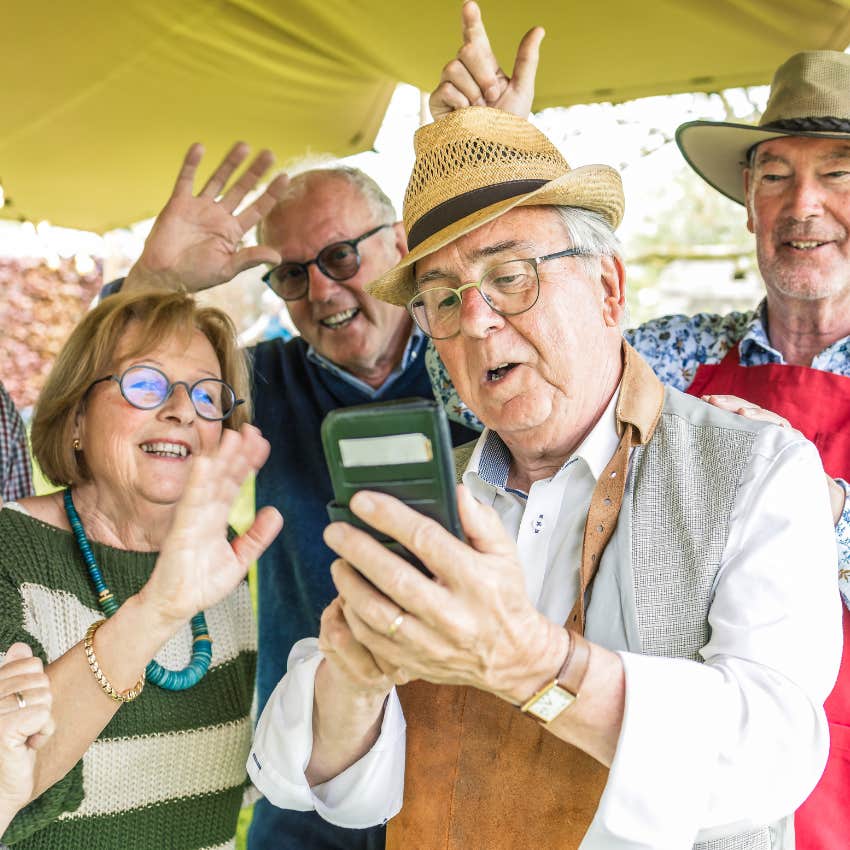The One Habit Most Super-Agers Share — And Why It Protects Your Brain, Says Longevity Doctor
After 25 years of research, here’s the key to staying sharp into your 80s, 90s, and beyond.
 MixMedia | Canva
MixMedia | Canva Aging frightens most people. The ancients personified it as a ghostly figure. The Greeks called him Geras, a bent and shriveled spirit trailing behind the strong gods of Olympus. To grow old was to be exiled from the banquet of the living.
Shakespeare captured the dread with almost cruel precision. In As You Like It, he describes old age as “second childishness and mere oblivion.”
Literature has rarely been kind to the elderly. Tolstoy’s Ivan Ilyich faced his decline with terror and despair. Hemingway’s Santiago in The Old Man and the Sea fought valiantly, but his battle was framed as futile.
Modern cinema has not helped. We see a decline in the fading portrait of Dorian Gray, the backward arc of Benjamin Button, and the lonely march of Clint Eastwood in Gran Torino. Aging, in art as in medicine, is framed as erosion.
And yet, against this background of decline, there are always outliers. Michelangelo carved the Pietà in his seventies. Frank Lloyd Wright designed the Guggenheim in his eighties. Toni Morrison published Home at 81. Clint Eastwood, the same man who limped across Gran Torino, directed Richard Jewell at 89.
These figures remind us that aging is not a one-way march into shadow. Something in the brain, in the spirit, can stay startlingly alive. Scientists have given this phenomenon a name: the super-ager.
What is the habit that super-agers share? Social connection.
 oneinchpunch / Shutterstock
oneinchpunch / Shutterstock
Super-agers are not simply people who live long. They are people in their eighties and nineties who perform on memory tests as well as those decades younger.
Their brains defy the usual script of shrinkage and fray. Instead, their cognitive performance stays sharp, their recall vivid, their attention resilient.
The Northwestern SuperAging Study began in 2000. It has tracked people 80 and older who still score as well on memory tests as the average 50- or 60-year-old.
After 25 years of data, one theme rose above all others. Not relentless exercise. Not crossword puzzles. Not kale or omega-3s. Social connection.
Why social connection protects the brain
It is easy to romanticize. But the data are clear. Super-agers are not hermits meditating in silence.
They are men’s chorus singers. Lifelong Cubs fans. Retired copywriters who still paint with neighborhood kids. Women who walk to the market every day because they know the fishmonger by name.
Neuroscientists have found that these elders preserve more von Economo neurons. These specialized cells support social behaviors and are also found in elephants, whales, and apes.
They also maintain larger brain volume, more resilient synapses, and lower markers of inflammation. When we connect with others, cortisol falls, protective neurochemicals rise, and neural circuits stay active.
Loneliness, by contrast, bathes the brain in stress hormones and accelerates atrophy. Every conversation is a workout. Every laugh is a shield.
My mother’s story
I do not have to look far to find a super-ager. My mother is 90 years old, and she is thriving. She walks three miles a day, rain or shine. Her mind is as sharp as ever. She has no health issues whatsoever.
She never smoked. Never drank. Never touched drugs. She has exercised her whole life, mainly walking. She sleeps well, eats modestly, and keeps a steady rhythm of meeting friends.
When I visit, I am struck not only by her physical vitality but by her presence of mind. She recalls names, dates, and stories with the clarity of someone decades younger. She laughs easily. She listens deeply.
She shows me, by example, that aging well is not about avoiding birthdays. It is about building a life where body, brain, and relationships are tended daily.
Watching her has convinced me that the habits we stack over time — walking, connecting, resting, caring — are what truly protect the mind.
She is not a medical anomaly. She is the living embodiment of what research now confirms: connection, purpose, and movement are medicine.
Philosophy and poetry on companionship
 Mr.vicpix / Shutterstock
Mr.vicpix / Shutterstock
The idea is ancient. Aristotle described humans as zoon politikon, social animals. To cut us off from others was to cut us off from our nature.
Montaigne, centuries later, wrote that “to love is the greatest of all lessons.” He was not referring to romance alone but to the wider field of human friendship. Emily Dickinson, despite her reclusiveness, confessed: “My friends are my estate.”
Even the reclusive poets could not thrive without a web of connections. In film, the lesson repeats. It’s a Wonderful Life does not end with riches but with George Bailey surrounded by friends.
In Kurosawa’s Ikiru, a bureaucrat discovers meaning not in solitude but in building a playground for children. Pixar’s Up begins with loss and isolation but resolves in new friendship, proving that connection can resurrect the spirit even in the final chapters of life.
The truth is as old as the story itself. A mind cut off from others grows brittle. A mind in company stays pliant.
The science of super-aging brains
What do the brains of super-agers actually show?
- Brain Volume: Their cortex resembles that of someone 20 to 30 years younger.
- Von Economo Neurons: Denser in super-agers, these rare cells are tied to empathy and social intuition.
- Neurochemistry: They preserve higher function in acetylcholine circuits, critical for attention and memory.
- Resistance to Alzheimer’s: While most octogenarians show plaques and tangles, many super-agers have remarkably little.
- Functional Connectivity: Their brain networks remain tightly linked, especially in regions tied to memory and emotion.
In essence, they resist the fray, and connection is the glue. A patient of mine, age 84, joined a late-in-life poetry group. He swore it kept his memory alive more than any pill.
He memorized verses, argued about lines, and laughed at disagreements. His scans looked like those of someone fifteen years younger. Science meets sonnets.
Why loneliness is so toxic
Loneliness is not just sad. It is a biological poison. It raises cortisol, fuels inflammation, erodes sleep, and damages the hippocampus, the brain’s memory hub.
Studies link isolation with a higher risk of dementia, heart disease, depression, and early death. By contrast, social interaction lights up the brain like fireworks.
Conversation fires language, memory, motor, and emotion all at once. It is cognitive cross-training of the highest order. The act of socializing is not fluff. It is neurological scaffolding.
In my clinic, I see it every week. Patients who come alone to radiation treatments often seem smaller. They slouch, answer briefly, gaze down.
Those who arrive with a spouse, a daughter, or a friend bring different energy. They joke with nurses. They ask sharper questions. They walk taller. Science can measure brain scans and neuron counts. I see it in faces.
One man in his late eighties arrived with his son every day. They laughed about baseball, argued about politics, and brought the waiting room to life. His treatment went smoothly.
Another, a decade younger, came alone. His body endured, but his spirit seemed to fray.
I have learned that survival is not only about cells. It is about connections.
Practical habits for super-aging
Not everyone is a natural extrovert. Not everyone has neighbors who host block parties. But the habits of super-agers can be borrowed and practiced:
- Join something rhythmic. Choirs, dance groups, tai chi.
- Volunteer. Teaching, mentoring, helping. Purpose plus people is a double win.
- Cultivate younger friends. Intergenerational ties keep perspectives fresh.
- Schedule sociability. Make it as non-negotiable as exercise.
- Reclaim rituals. Weekly dinners, holiday gatherings, and monthly walks.
- Stay curious. Ask questions. Listen deeply.
- Mix environments. Book clubs, gyms, religious groups, and walking groups.
- Use technology wisely. A video call is better than no call, but prioritize in-person when possible.
- Seek novelty. Travel, classes, and new hobbies. Each brings fresh networks of people.
- Make the connection the default. Say yes more often. Show up even when tired. Presence outlasts eloquence.
The philosophers suspected it. The poets sang it. The neuroscientists confirm it.
We do not keep our minds sharp in isolation. We keep them sharp by leaning toward others, by showing up again and again at choirs, ballparks, dinner tables, and hospital waiting rooms.
If there is one lesson from the super-agers, it is this: memory is not just neurons firing. It is voices echoing. The mind stays sharp when the heart stays open.
So when you are tempted to retreat into solitude, remember: the greatest act of brain health may be as simple as picking up the phone, knocking on a neighbor’s door, or singing an old song with friends.
Because in the end, we do not just remember. We are remembered.
Dr. Michael Hunter has degrees from Harvard, Yale, and the University of Pennsylvania. He is the author of the ebook: Extending Life and Healthspan.

